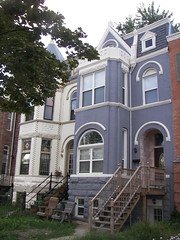Living in a historic district
"Harsh Realities for Those Who Buy Historic" is an article in today's Washington Post. To me, the target reader for the story is the suburbanite, not the urbanite. I wrote about this on an elist earlier today.
I was in Richmond last weekend, and we went into a couple of open houses. One was a 2.5 story rowhouse on The Boulevard on the edge of the Fan District, a couple blocks from the Fine Arts Museum. It was a nice house basically, that had been screwed up by the renovator. The house is from 1915. The kitchen was modernized but in a way that detracted from the architectural character of the house, and throughout the house, fixtures were used from eras that just didn't fit the natural beauty and character of the house. (Plus the bathrooms were screwed up too....)
Many of the tear downs and house abortions we see in the city are driven by developers who are trying to be responsive to "modern" buyers. I think that is a mistake. Slowly, albeit very slowly, houses are being reproduced along the lines of much larger suburban styled houses, and neighborhoods are changing both in terms of the building stock as well as the type of person who lives there.
See the story "This New House" from Mother Jones Magazine for more about how the typical American house has doubled in size over the past few decades.
 I think we need to do a better job highlighting why the architectural characteristics of historic houses and the urban design characteristics of historic neighborhoods matter, in order to better attract the people who are disposed to living a lifestyle that is urban.
I think we need to do a better job highlighting why the architectural characteristics of historic houses and the urban design characteristics of historic neighborhoods matter, in order to better attract the people who are disposed to living a lifestyle that is urban.E.g., sure parking is a problem in places with a lot of demand. OTOH, you don't necessarily need a car, you can use transit, walk, or bicycle, supplemented by car sharing and/or taxis depending on the density, character, and amenities available within your neighborhood. That saves you the $500-$700/monthly cost of a car. Etc.
But this is the difference between thinking urbanistically vs. being shaped by the suburban land use and planning paradigm of deconcentrated and separated land use, linked by and coupled with automobile based mobility--and wanting to remake the city over to fit the suburban paradigm.
-------
Note that I am preparing a proposal to interest some DC Government agencies on producing a set of materials that begin to explain these broad principles, to build the base of understanding about the basic architecturally historic elements of DC's historic residential building stock.




0 Comments:
Post a Comment
<< Home